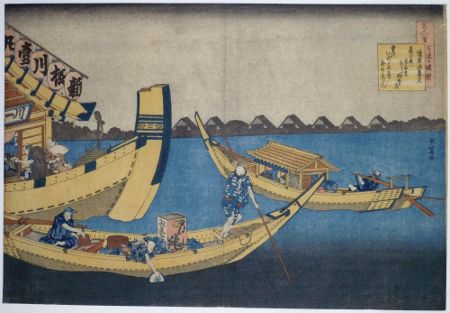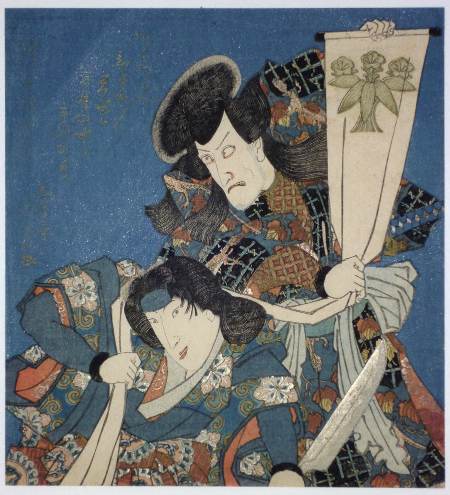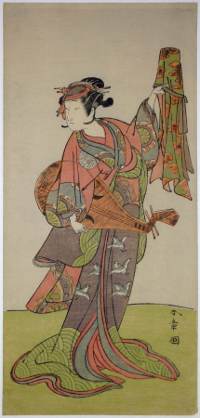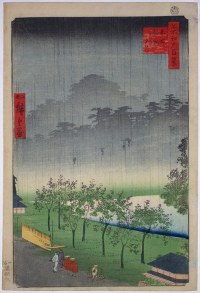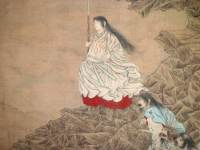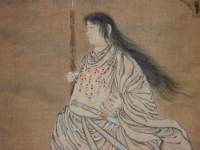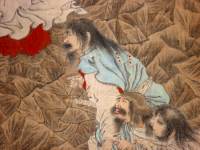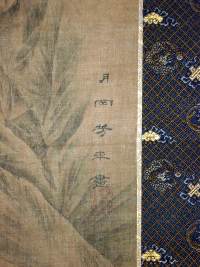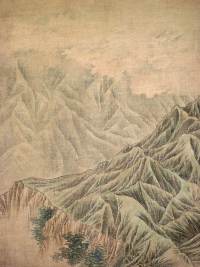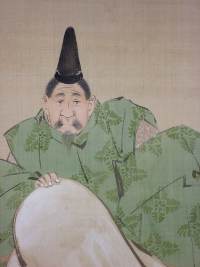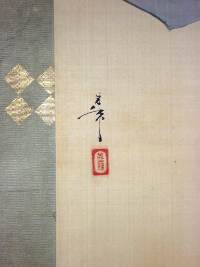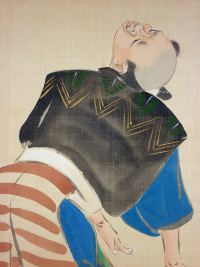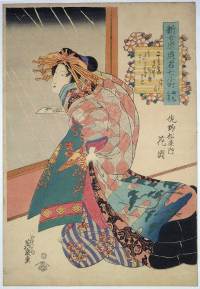Katsushika HOKUSAI (1760-1849)
Click here to view image full size.
A poem by Kiyowara no Fukayabu from Hyakunin isshu uba ga etoki, the “Hundred Poems explained by the Wet Nurse.” Published by Nishimuraya Eijudo and Iseya Eijudo c 1835/6. Although obviously intended to be a set of 100 prints, only 27 are known plus drawings for the others. The poet speaks of the shortness of the summer night and asks if the moon is still overhead or hidden by clouds. Shows an evening on the Sumida River with a large pleasure boat accompanied by a smaller craft and a vessel providing food.
Fine early impression. Fine colour. Slight centre fold, otherwise good condition. Signed Zen Hokusai manji (the manji seal black).
Status: Sold
Utagawa KUNISADA (1786-1864)
Click here to view image full size.
A surimono showing the kabuki actors, top right: Ichikawa Danjuro VII holding up a war banner decorated with a sasarindo (bamboo grass and gentian), the mon of the Minamoto clan and Iwai Hanshiro V wielding a large knife in an unidentified play. The poem mentions the Iwai and Ichikawa family names. Published c 1827-30.
Fine impression and colour with blind-printing, silver and gold. Signed in gold on the blue ground Gototei Kunisada ga.
Status: Sold
Katsukawa SHUNSHO (1726-1792)
Click here to view image full size.
The actor Nakamura Tomijuro I in an unidentified female role holding a biwa (a lute-like musical instrument) underarm. Surprisingly not listed in The Life And Works Of Katsukawa Shunsho, Frederick William Gookin, which is the most comprehensive overview. Published c 1775/6.
Fine impression and colour. One small repaired wormhole, otherwise exceptional condition. Signed Shunsho ga.
Status: Sold
Utagawa HIROSHIGE II (1826-1869)
Click here to view image full size.
Akasaka kiribatake uchu sekikei, “Evening View of the Paulownia Plantation at Akasaka Under Rain.” This is the replacement design for Hiroshige I’s version Akasaka kiribatake for the Meisho Edo hyakkei, “One Hindred Views of Edo” published by Uoya Eikichi between 1856 and 1858. This design dated 1859. Presumably the blocks were damaged for the first composition. A fine design and superior to Hiroshige I’s.
Fine early impression with mica to sky. There is an extremely rare first edition of this print with an added gradation of yellow to square cartouche and gradation on the yellow fence at left and roofs at right. Otherwise, the impressions are the same. The gradation in the background is particularly fine here. Fine colour. Slight soil to margin, otherwise very good condition. Signed Nisei Hiroshige ga.
Status: Sold
Tsukioka YOSHITOSHI (1839-1892)
Click here to view image full size.
An important two-fold screen, Yamatotakeruno mikoto at Mount Azuma. Yamatotakeru was the beautiful but fiery tempered third son of the Emperor Keikou (71B.C.-130 A.D.) He also had magical powers given to him by his aunt. His father decided to send him to the Eastern Provinces to subdue the barbarians. On the way aboard a boat, they encountered a violent storm. His wife, Ota-tachibana, threw herself in the sea to appease the Gods and drowned. Yamatotakeru continues his journey and reaches a rocky landscape. He gazes south east and in memory of his wife repeats three times “Azuma haya” (My wife, alas). Thus the mountain and area became known as Azuma. This is the scene Yoshitoshi depicts with Yamatotakeru surrounded by his entourage, gazing ahead, his long hair flowing. (He was able to pass as a woman in disguise, evidently.) Yoshitoshi had a jagged style of drawing and painting and the multitude of craggy outcrops allow him to fully indulge himself.
Full colour on silk, each panel 39.75 x 25 in; 101 x 63.5 cms. Extremely good condition. Signed Kinzaburo Yoshitoshi ga with blurred seal but reading Go Kaisai. Extremely rare.
Status: Sold
Tsukioka YOSHITOSHI (1839-1892)
Click here to view image full size.
An original painting, Hokosorori zu, showing Sorori Shinzaemon (at bottom) and Toyotomi Hideyoshi (1536-1598). Sororai was a sword sheath maker and otogishu to Hideyoshi (storyteller to attending provincial lords). “Sorori” means smooth and quiet, the name given to him because any sword fit his sheaths so perfectly. The episode depicted concerns Hideyoshi lamenting the fact that his face looked like a monkey. Sorori cleverly tells him that he is lucky that monkeys respect him to such a degree that they try to look like him. Hideyoshi enjoys the reply and inquires what he would like as a reward. Sorori asks him for a grain of rice to be doubled-up every day for one hundred days. After this period Hideyoshi realises his mistake and demands that Sorori change the reward.
Full colour on silk, image size 34.75 x 11.5 in; 88.2 x 29.2 cms. In very good condition. Beautiful mount. Signed Yoshitoshi with Taiso seal.
Status: Sold
Keisai EISEN (1790-1848)
Click here to view image full size.
The courtesan Hanaoka of the Sanomatsuya House in the Shin Yoshiwara looking out at the rain and holding a poem slip. Episode Amagoi from a Seven Komachi set: Shin Yoshiwara yugimi nana Komachi. The set based on the seven episodes in the life of the famous 9th century poetess Ono no Komachi. Published by Tsuta-ya, c 1830.
Very good impression. This is the first state with gradation in the sky and at the end of Hanaoka’s robe. Superb, unfaded colour. Fine condition; full size. Signed Keisai Eisen ga.
Status: Sold
